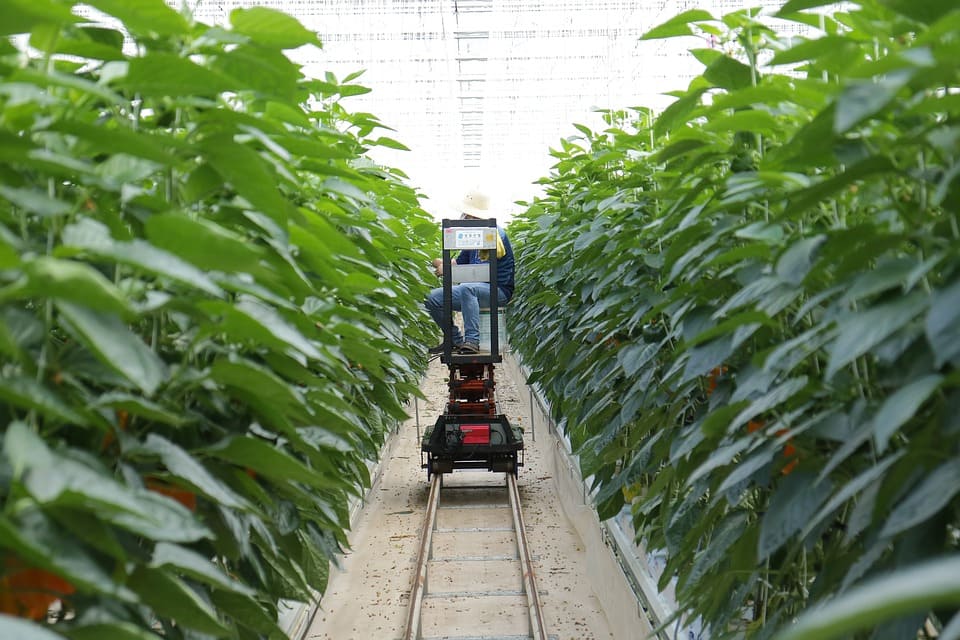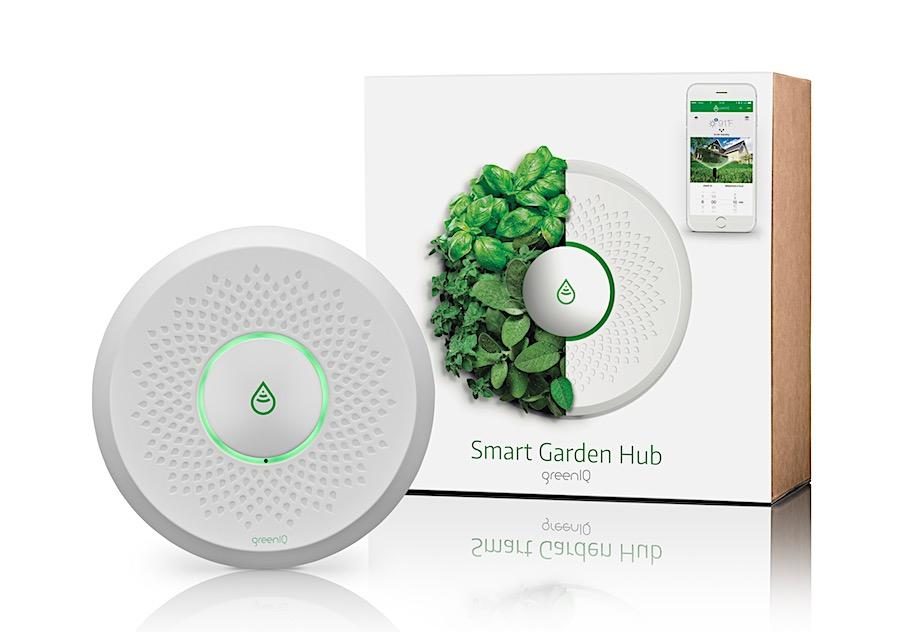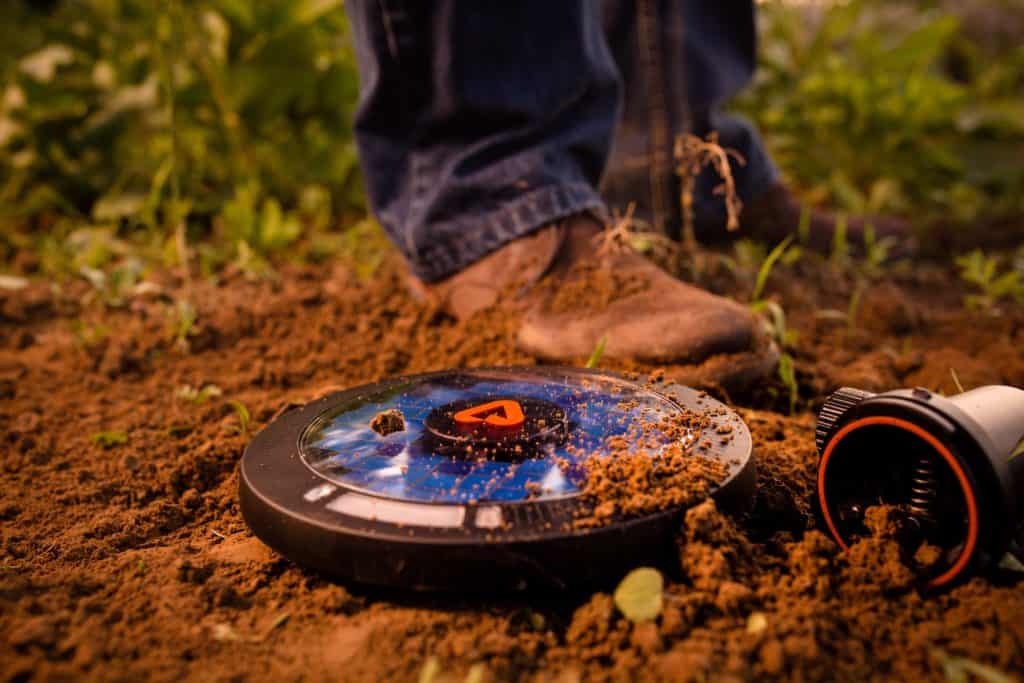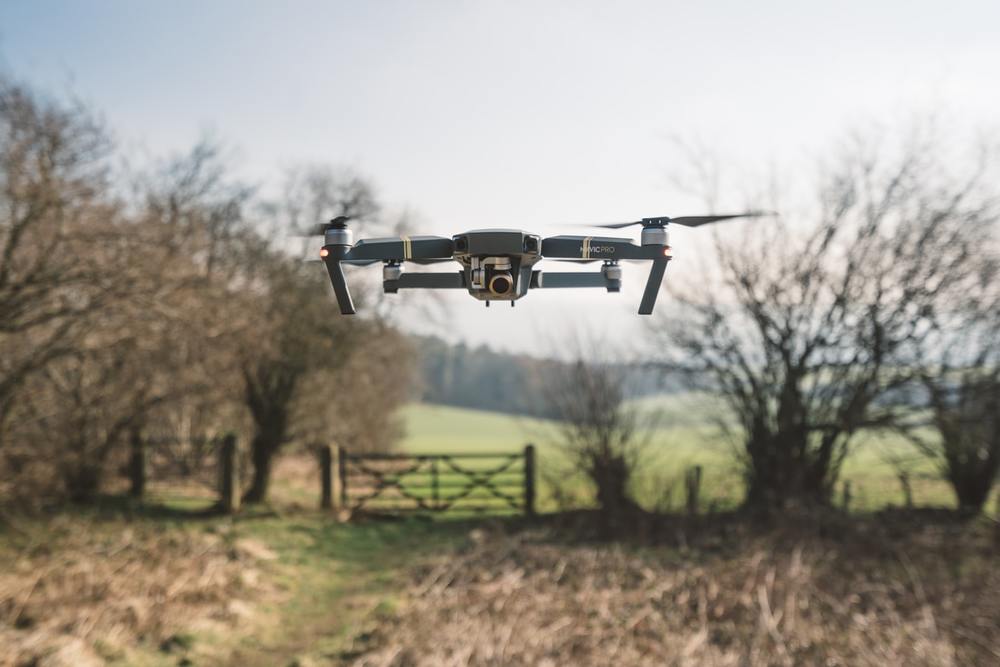What Is the Best Fox Farm Fertilizer to Use With Cut and Come Again Lettuce
The commodity was updated on July 7, 2020.
With the growing adoption of the Internet of Things (IoT), connected devices have penetrated every attribute of our life , from wellness and fitness, domicile automation, automotive and logistics, to smart cities and industrial IoT.
Thus, information technology is only logical that IoT, connected devices, and automation would observe its application in agriculture, and as such, tremendously improve well-nigh every facet of information technology. How could one however rely on horses and plows when self-driving cars and virtual reality are no longer a sci-fi fantasy merely an everyday occurrence?
Farming has seen a number of technological transformations in the last decades, becoming more industrialized and technology-driven. By using various smart agriculture gadgets, farmers accept gained better command over the process of raising livestock and growing crops, making it more anticipated and improving its efficiency.
This, along with the growing consumer demand for agriculture products, has contributed to the increased proliferation of smart farming technologies worldwide. In 2020, the market share for IoT in agriculture reached $five.vi billion.
In this article, we will explore the IoT use cases in agronomics and examine their benefits. So, if you are because investing into smart farming, or are planning to build an IoT solution for agriculture, dive right in.
What is smart agronomics? The definition and market size
There are many ways to refer to mod agriculture. For example, AgriTech refers to the application of engineering science in agriculture in full general.
Smart agriculture, on the other manus, is mostly used to denote the application of IoT solutions in agriculture. So what is smart agriculture using IoT? Past using IoT sensors to collect ecology and machine metrics, farmers tin make informed decisions, and improve but most every aspect of their work – from livestock to crop farming.
For instance, by using smart agriculture sensors to monitor the land of crops, farmers can ascertain exactly how many pesticides and fertilizers they accept to utilize to attain optimal efficiency. The aforementioned applies to the smart farming definition.

Although smart agriculture IoT, likewise equally industrial IoT in full general, aren't as popular as consumer connected devices; yet the market is all the same very dynamic. The adoption of IoT solutions for agriculture is constantly growing. Namely, COVID-nineteen has had a positive impact on IoT in the agriculture marketplace share. Disruptions in the supply chain, and the shortage of qualified workers, has propelled its CAGR to nine,ix%. In fact, every bit per recent reports, the smart framing marketplace share is gear up to accomplish $6.ii billion by 2021.
At the same time, the global smart agronomics market size is expected to triple by 2025, reaching $fifteen.3 billion (compared to existence slightly over $5 billion back in 2016).
Because the market place is still developing, there is still ample opportunity for businesses willing to join in. Edifice IoT products for agriculture inside the coming years can set yous autonomously equally an early adopter, and equally such, assist you lot pave the way to success.
Just why should you consider building an IoT application for agriculture in the first place?
The Benefits of smart farming: How'south IoT shaping agriculture
Technologies and IoT have the potential to transform agronomics in many aspects. Namely, there are five ways IoT can improve agronomics :
- Data, tons of data, collected past smart agriculture sensors, e.g. weather conditions, soil quality, crop's growth progress or cattle's health. This information can be used to runway the state of your business in general as well as staff performance, equipment efficiency, etc.
- Better command over the internal processes and, every bit a effect, lower production risks . The ability to foresee the output of your product allows you lot to plan for better product distribution. If you know exactly how much crops you are going to harvest, you tin make certain your product won't lie around unsold.

- Cost direction and waste material reduction thanks to the increased control over the production . Beingness able to see any anomalies in the crop growth or livestock health, you will be able to mitigate the risks of losing your yield.
- Increased business efficiency through process automation . By using smart devices, you lot tin automate multiple processes beyond your production cycle, east.m. irrigation, fertilizing, or pest control.
- Enhanced product quality and volumes . Reach meliorate command over the product process and maintain higher standards of crop quality and growth capacity through automation.
Equally a result, all of these factors can eventually lead to higher revenue .
At present that nosotros take outlined how IoT can be advantageously applied in the sphere of agriculture, let's have a look at how the listed benefits tin can find their application in real life.
IoT use cases in agriculture (with examples)
There are many types of IoT sensors for agriculture as well as IoT applications in agronomics in full general:
i.Monitoring of climate weather
Probably the most popular smart agriculture gadgets are atmospheric condition stations, combining diverse smart farming sensors. Located across the field, they collect various data from the environment and send it to the deject. The provided measurements can be used to map the climate conditions, choose the appropriate crops, and take the required measures to improve their capacity (i.e. precision farming).
Some examples of such agriculture IoT devices are allMETEO , Smart Elements , and Pycno .

2. Greenhouse automation
Typically, farmers utilize manual intervention to control the greenhouse environment. The use of IoT sensors enables them to get accurate real-time information on greenhouse weather such as lighting, temperature, soil status, and humidity.
In addition to sourcing environmental data, weather stations can automatically suit the conditions to match the given parameters. Specifically, greenhouse automation systems use a similar principle.
For instance, Farmapp and Growlink are too IoT agriculture products offering such capabilities among others.
GreenIQ is besides an interesting product that uses smart agriculture sensors. It is a smart sprinklers controller that allows you to manage your irrigation and lighting systems remotely.

3. Crop management
One more type of IoT production in agriculture and another element of precision farming are crop direction devices. Just like weather condition stations, they should exist placed in the field to collect data specific to crop farming; from temperature and precipitation to leaf water potential and overall crop health.
Thus, yous can monitor your crop growth and whatever anomalies to finer preclude any diseases or infestations that can damage your yield. Arable and Semios can serve equally skillful representations of how this use case can be applied in real life.

4. Cattle monitoring and management
Only like crop monitoring, there are IoT agriculture sensors that tin can exist fastened to the animals on a farm to monitor their wellness and log functioning. Livestock tracking and monitoring help collect data on stock health, well-beingness, and physical location.
For instance, such sensors can identify sick animals and so that farmers can separate them from the herd and avoid contagion. Using drones for real-time cattle tracking also helps farmers reduce staffing expenses. This works similarly to IoT devices for petcare .
For instance, SCR by Allflex and Cowlar employ smart agronomics sensors (neckband tags) to deliver temperature, health, action, and diet insights on each individual cow as well equally collective information about the herd.

five. Precision farming
Too known as precision agriculture, precision farming is all about efficiency and making accurate data-driven decisions. It's besides i of the virtually widespread and effective applications of IoT in agriculture.
By using IoT sensors, farmers tin collect a vast array of metrics on every facet of the field microclimate and ecosystem: lighting, temperature, soil condition, humidity, CO2 levels, and pest infections. This data enables farmers to estimate optimal amounts of water, fertilizers, and pesticides that their crops need, reduce expenses, and raise better and healthier crops.
For case, CropX builds IoT soil sensors that measure soil moisture, temperature, and electrical conductivity enabling farmers to approach each crop's unique needs individually. Combined with geospatial information, this technology helps create precise soil maps for each field. Mothive offers similar services, helping farmers reduce waste, ameliorate yields, and increase farm sustainability.
half-dozen. Agricultural drones
Perhaps one of the nearly promising agritech advancements is the utilize of agricultural drones in smart farming. Also known every bit UAVs (unmanned aeriform vehicles), drones are amend equipped than airplanes and satellites to collect agricultural data. Autonomously from surveillance capabilities, drones can also perform a vast number of tasks that previously required human labor: planting crops, fighting pests and infections, agriculture spraying, ingather monitoring, etc.
Read more: Why Use Agriculture Drones? Main Benefits and Best Practices
DroneSeed , for instance, builds drones for planting trees in deforested areas. The use of such drones is 6 times more effective than human being labor. A Sense Fly agriculture drone eBee SQ uses multispectral prototype analyses to guess the wellness of crops and comes at an affordable price.

vii. Predictive analytics for smart farming
Precision agronomics and predictive data analytics go hand in hand. While IoT and smart sensor engineering are a goldmine for highly relevant existent-time data, the use of data analytics helps farmers brand sense of it and come with important predictions: crop harvesting fourth dimension, the risks of diseases and infestations, yield volume, etc. Data analytics tools aid make farming, which is inherently highly dependent on conditions conditions, more manageable, and predictable.
For example, the Crop Functioning platform helps farmers access the book and quality of yields in advance, as well equally their vulnerability to unfavorable weather conditions, such as floods and drought. It also enables farmers to optimize the supply of h2o and nutrients for each ingather and even select yield traits to improve quality.
Practical in agriculture, solutions like SoilScout enable farmers to relieve upwardly to fifty% irrigation water, reduce the loss of fertilizers acquired by overwatering, and deliver actionable insights regardless of flavor or weather conditions.
8. End-to-end farm management systems
A more complex arroyo to IoT products in agronomics can be represented past the so-called farm productivity direction systems. They ordinarily include a number of agronomics IoT devices and sensors, installed on the premises equally well as a powerful dashboard with belittling capabilities and in-built accounting/reporting features.
This offers remote farm monitoring capabilities and allows you to streamline virtually of the business organisation operations. Similar solutions are represented by FarmLogs and Cropio .
In addition to the listed IoT agronomics use cases, some prominent opportunities include vehicle tracking (or even automation), storage direction, logistics, etc.

Things to consider before developing your smart farming solution
As nosotros can come across, the use cases for IoT in agriculture are endless. There are many means smart devices can assistance y'all increment your farm's performance and revenue. However, agriculture IoT apps development is no easy task. There are sure challenges y'all need to be enlightened of if y'all are considering investing into smart farming.
i. The hardware
To build an IoT solution for agriculture, you need to choose the sensors for your device (or create a custom i). Your selection will depend on the types of information you desire to collect and the purpose of your solution in full general. In whatever case, the quality of your sensors is crucial to the success of your product: information technology will depend on the accuracy of the collected data and its reliability.
2. The encephalon
Information analytics should be at the core of every smart agriculture solution. The collected data itself will be of niggling help if you lot cannot make sense of it. Thus, you need to have powerful data analytics capabilities and apply predictive algorithms and automobile learning in club to obtain actionable insights based on the collected data.
3. The maintenance
Maintenance of your hardware is a challenge that is of main importance for IoT products in agronomics, equally the sensors are typically used in the field and tin can be easily damaged. Thus, yous need to make sure your hardware is durable and like shooting fish in a barrel to maintain. Otherwise you will need to supplant your sensors more often than you would like.
4. The mobility
Smart farming applications should be tailored for use in the field. A business owner or farm manager should be able to access the information on site or remotely via a smartphone or desktop estimator.
Plus, each connected device should be autonomous and accept enough wireless range to communicate with the other devices and transport data to the primal server.

5. The infrastructure
To ensure that your smart farming application performs well (and to make sure information technology can handle the data load), you demand a solid internal infrastructure.
Furthermore, your internal systems have to be secure. Declining to properly secure your system merely increases the likeliness of someone breaking into it, stealing your data or even taking control of your autonomous tractors.
6. Connectivity
The need to transmit data betwixt many agronomical facilities still poses a challenge for the adoption of smart farming. Needless to say, the connexion between these facilities should be reliable enough to withstand bad weather condition weather condition and to ensure non-disruptive operations. Today, IoT devices still use varying connection protocols, although the efforts to develop unified standards in this expanse are currently underway. The advent of 5G and technologies like space-based Net will, hopefully, help discover a solution to this problem.
vii. Data drove frequency
Because of the high diverseness of information types in the agricultural manufacture, ensuring the optimal data drove frequency can be problematic. The data from field-based, aerial and environmental sensors, apps, mechanism, and equipment, as well equally processed analytical data, tin be a bailiwick of restriction and regulations. Today, the safe and timely delivery, and sharing of this information is one of the current smart farming challenges.
eight. Data security in the agriculture manufacture
Precision agriculture and IoT engineering imply working with large sets of data, which increases the number of potential security loopholes that perpetrators can use for data theft and hacking attacks. Unfortunately, data security in agriculture is still, to a big extent, an unfamiliar concept. Many farms, for example, utilise drones that transmit data to farm machinery. This mechanism connects to the Cyberspace but has little to zero security protection, such every bit user passwords or remote access authentications.
Some of the basic IoT security recommendations include monitoring data traffic, using encryption methods to protect sensitive information, leveraging AI-based security tools to discover traces of suspicious activity in real-time, and storing data in the blockchain to ensure its integrity. To fully do good from IoT, farmers will have to become familiar with the data security concept, set up internal security policies, and adhere to them.

Grow your agronomics business with smart IoT solutions from Eastern Peak
According to the UN Food and Agriculture Organization (FAO) , the global population is expected to surpass 9 billion people by 2050. To produce plenty nutrient for the given population, agronomics product volumes have to increase by fifty%.
As the resources for agricultural operations are limited (almost of the lands suitable for farming are already in apply), the only way to increase volume is to improve production efficiency. There is no uncertainty as to the extent with which smart farming can help tackle this challenge; in fact, it seems that information technology is not possible without it. Here at Eastern Peak nosotros develop custom IoT solutions for agriculture, tailored to your particular needs.
How to become started?
From cattle tracking to advanced field mapping, IoT applications in smart agriculture vary from farm to farm depending on your market segment, climate, and region. In many instances, out-of-the-box tools won't be relevant, and yous may need a tailored smart farming IoT solution. At Eastern Pinnacle we arroyo each client individually to meet their unique needs.
The product discovery phase is the best starting time step you can take to lay a solid foundation for the evolution of your app. It includes a functional specification, UX/UI design, and a visual prototype that volition requite you a clear vision of the cease product. On average, this phase takes 4-half dozen weeks.
The product discovery phase can help yous:
- ascertain a full scope of piece of work and develop a roadmap for the project
- set a realistic budget for your MVP and plan your resource
- test the waters with your audition using a visual prototype
- craft a convincing investment pitch
- get to know your squad
We at Eastern Pinnacle have already helped many startups and Fortune 500 companies digitize and streamline their operations with the help of technologies. We provide end-to-end services building IoT solutions across a number of concern domains, from hardware blueprint to software development, testing, and integration.
To receive professional consultation from our experts, arrive touch with united states using our contact grade.
Read also:
- Smart Farming: How Automation Is Transforming Agriculture
- 3 Edge Calculating Use Cases for Smart Farming
- Smart Agriculture Monitoring Solutions to Optimize Farming Productivity
- half-dozen Cool Examples of Internet of Things Applications and How to Develop Ane
Source: https://easternpeak.com/blog/iot-in-agriculture-technology-use-cases-for-smart-farming-and-challenges-to-consider/
0 Response to "What Is the Best Fox Farm Fertilizer to Use With Cut and Come Again Lettuce"
Post a Comment